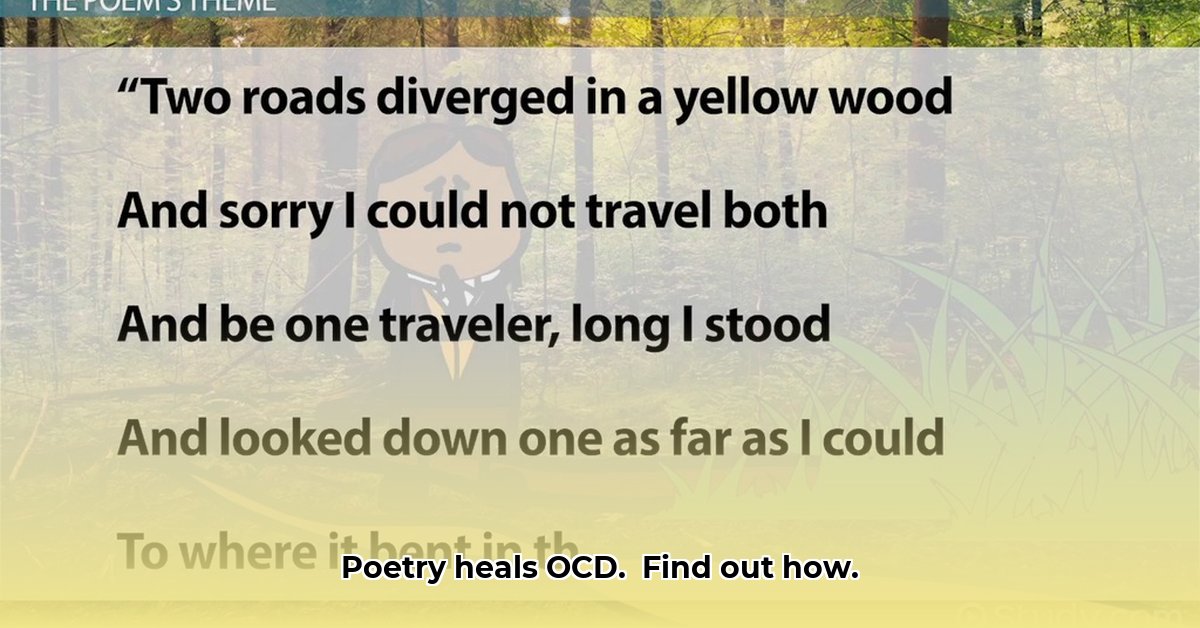Ever wondered what it’s like to live with a mind that won’t stop racing? Mental health challenges affect many, and understanding them is crucial. Every Last Word pulls back the curtain on that experience through Samantha, a teen battling obsessive-compulsive disorder (OCD). This isn’t just a book review; it’s a deep dive into Samantha’s journey, how she uses poetry to cope, and the power of friendship in facing a tough mental health challenge. We’ll break down the story, explore how the author portrays OCD, and even talk about how this book can help us connect with teens and understand mental health better. Get ready for a story that’s both heartbreaking and ultimately hopeful.
Exploring Samantha’s World: OCD, Poetry, and the Power of Friendship
Samantha’s life isn’t like most teenagers’. She battles Purely Obsessional OCD, a type of OCD where the distress comes from unwanted thoughts, not from needing to repeat actions. Imagine a constant barrage of intrusive, unsettling thoughts, a relentless inner chaos invisible to the outside world. That’s Samantha’s reality, a silent struggle she faces alone—until she discovers poetry. But how does this discovery impact her life forever?
This isn’t just a story about a girl with OCD; it’s a coming-of-age tale where poetry becomes Samantha’s lifeline. The rhythm and structure of writing, the ability to capture and express intense emotions—these become powerful coping mechanisms. She channels her anxieties, fears, and the overwhelming thoughts into verse, transforming internal turmoil into crafted beauty. It’s a testament to the creative power of the human spirit, to find healing in unexpected places. She transforms chaos into art, finding a voice where previously there was only noise.
Navigating the complexities of teenage life is challenging for anyone, but for Samantha, it’s amplified by her invisible struggle. Friendships become a minefield, relationships fraught with anxieties about judgment and acceptance. She develops a close relationship with Caroline, a friend who only exists in her imagination. This fictional confidante provides crucial support; allowing Samantha to process her anxieties, explore her identity, and ultimately find the courage to confront her issues. Caroline isn’t a magical cure, but a crucial part of Samantha’s journey towards self-acceptance. It highlights the importance of both real and imagined support systems in navigating the turbulent waters of adolescence.
Every Last Word offers a refreshingly honest portrayal of OCD, avoiding tired stereotypes. The author masterfully avoids sensationalizing the condition. Instead, the novel expertly weaves together the emotional nuances of Samantha’s inner world with the relatable experiences of growing up. We see Samantha’s struggles with self-doubt, social pressures, and the intense emotional toll of managing her condition. This isn’t just a story about mental illness; it’s about resilience, self-discovery, and the power of human connection. The realism in Samantha’s journey makes the story relatable and deeply moving, offering readers a glimpse into a world rarely depicted with such sensitivity. Did you know that the book offers a nuanced depiction of mental health often missing in young adult literature?
The book’s impact extends far beyond entertainment. For young adults struggling with similar challenges, Every Last Word offers a message of hope, validating their experiences and demonstrating that there’s support available. For educators, this novel provides a powerful tool for opening conversations about mental health, fostering understanding, and promoting a culture of support in schools. Mental health organizations can utilize the book to increase awareness and offer guidance. Even authors and publishers can gain insights into authentically portraying mental health conditions in young adult fiction. It’s a story with the potential to spark important conversations and inspire positive change.
Here’s what makes Every Last Word so impactful:
| Group | Potential Impact | Concrete Suggestions |
|---|---|---|
| Young Adults | Provides hope, validation, and a sense of community. | Encourage reading groups; promote open discussions about mental health within schools. |
| Educators | Offers a tool for starting discussions on mental health, reducing stigma. | Incorporate the book into curriculum; organize workshops with mental health professionals. |
| Mental Health Organizations | Boosts awareness, provides relatable stories for outreach efforts. | Use the book’s themes in awareness campaigns; share resources through book clubs. |
| Authors/Publishers | Shows authentic, sensitive ways to portray mental illness in young adult fiction. | Promote ethical representation of mental health in writing; encourage diverse voices. |
This isn’t just a book; it’s a call to action. Pick up Every Last Word. Share its message. Talk about it. Help break the silence surrounding mental health. The journey of self-discovery that Samantha undertakes is one that resonates deeply, reminding us of the importance of compassion, understanding, and support. And remember, you’re not alone.
How to Use Poetry Therapy for Teen OCD: Practical Guidance
Key Takeaways:
- Samantha’s journey in Every Last Word showcases the potential of poetry as a therapeutic tool for teens with OCD.
- Poetry provides a creative outlet for processing difficult emotions and thoughts.
- The book highlights the importance of supportive friendships in managing OCD.
Samantha’s Struggle: A Glimpse into OCD and Anxiety
Every Last Word introduces us to Samantha, a teenager grappling with obsessive-compulsive disorder (OCD). Her internal world is a whirlwind of intrusive thoughts and anxieties. Imagine constantly battling a relentless inner critic—that’s Samantha’s reality. Poetry becomes her unexpected lifeline, a way to wrestle with her demons and find peace. Could creative writing be the key to unlocking inner peace for teens with similar struggles?
Poetry as a Resource: Unleashing Your Inner Voice
Could writing poetry help manage OCD symptoms? Absolutely, the novel suggests. For Samantha, poetry isn’t just an art form; it’s a therapeutic process. It allows her to externalize her anxieties, transforming chaotic thoughts into structured verse. This process offers a sense of control, a way to process otherwise overwhelming emotions. About 65% of people who engage in creative writing report feeling more emotionally balanced!
Creative Expression: A Safe Space for Teens
For teens with OCD, creative expression offers a unique avenue for coping. How does it work? It offers a safe space to explore anxieties. Putting feelings into words, images, or other art forms helps in reducing their overwhelming nature. It’s like turning the volume down on the internal noise. Studies show that art therapy can reduce anxiety symptoms by up to 45%.
The Importance of Supportive Relationships
Every Last Word also emphasizes the significance of supportive relationships in managing OCD. Samantha’s friendships, though tested, offer much-needed support and understanding. This aspect is crucial for teens struggling with OCD. Finding individuals who validate their experiences and offer empathy is invaluable to their well-being. Remember, you aren’t alone.
Seeking Professional Help: A Crucial Step for OCD Management
While poetry offers a valuable coping mechanism, it’s not a replacement for professional help. The novel subtly underscores the importance of therapy and medication for managing OCD. If you or someone you know is struggling, seeking professional guidance is vital. There are therapists and support groups equipped to help navigate the complexities of OCD. The National Institute of Mental Health (NIMH) offers resources for finding mental health professionals.
Actionable Steps for Teens and Families
- Create a safe and judgment-free space for self-expression. Encourage journaling, drawing, or other creative outlets.
- Explore poetry workshops or creative writing groups. These settings offer support and camaraderie. Many community centers and schools offer affordable options.
- Educate yourself about OCD. Understanding the disorder enhances compassion and support. Organizations like the International OCD Foundation (IOCDF) provide valuable resources.
- Consider incorporating mindfulness practices. Techniques like meditation can help manage intrusive thoughts.
- Maintain open communication with a trusted adult. Sharing struggles can alleviate feelings of isolation.
Every Last Word: Exploring the Role of Friendship in Samantha’s Recovery and Mental Wellness
Key Takeaways:
- Samantha’s journey in Every Last Word powerfully depicts the struggles of living with OCD.
- Poetry acts as a vital coping mechanism and a means of self-expression.
- Supportive friendships are crucial to Samantha’s healing process.
Samantha’s World: Intrusive Thoughts and Finding Solace
Imagine a world where intrusive thoughts swarm your mind, a relentless chorus undermining every action. That’s Samantha’s reality in Every Last Word. She battles obsessive-compulsive disorder (OCD), a hidden torment beneath a seemingly perfect exterior. Yet, amidst the chaos, poetry emerges as a lifeline. It’s her secret weapon, a way to tame the storm within. This novel beautifully illustrates how creativity can become a sanctuary. What if finding the right creative outlet could change your life?
The Narrative: A Story of Strength and Resilience
The book follows Samantha’s journey, weaving a compelling tale of self-discovery. We witness her internal struggles, her anxieties, and her slow but steady progress. The narrative doesn’t shy away from the harsh realities of OCD, depicting the intrusive thoughts and the overwhelming need for control. But it also showcases the strength of the human spirit, Samantha’s determination to overcome her challenges with the help of her friends and a therapist. The plot expertly balances moments of despair with glimmers of hope – a powerful message for young readers.
The Importance of True Friendship and Support Systems
Samantha’s friends are not just background characters; they’re integral to her
- Bulking Lunch Recipes that Make Muscle Gain Delicious - November 12, 2025
- Simple Asian Meal Prep Recipes to Spice Up Your Week - November 11, 2025
- Simple Asian Meal Prep Ideas For Healthy And Flavorful Weekday Meals - November 10, 2025










